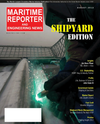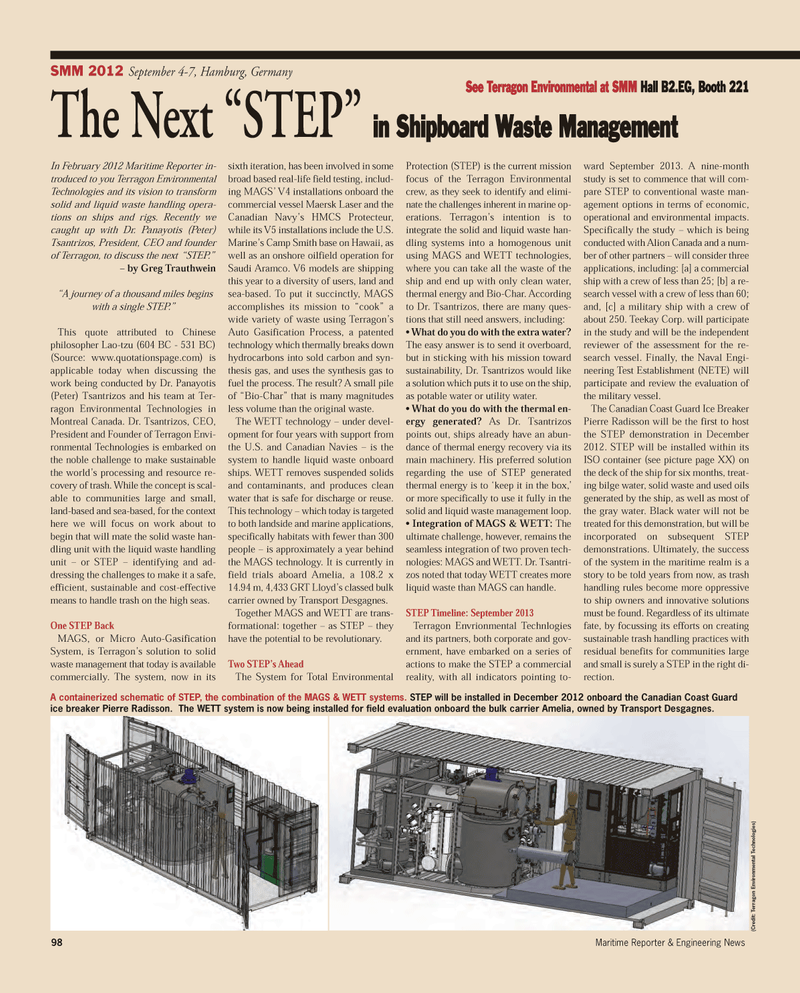
Page 98: of Maritime Reporter Magazine (August 2012)
The Shipyard Edition
Read this page in Pdf, Flash or Html5 edition of August 2012 Maritime Reporter Magazine
In February 2012 Maritime Reporter in- troduced to you Terragon Environmental Technologies and its vision to transform solid and liquid waste handling opera- tions on ships and rigs. Recently wecaught up with Dr. Panayotis (Peter) Tsantrizos, President, CEO and founder of Terragon, to discuss the next ?STEP.? ? by Greg Trauthwein ?A journey of a thousand miles begins with a single STEP.? This quote attributed to Chinese philosopher Lao-tzu (604 BC - 531 BC)(Source: www.quotationspage.com) is applicable today when discussing thework being conducted by Dr. Panayotis (Peter) Tsantrizos and his team at Ter- ragon Environmental Technologies in Montreal Canada. Dr. Tsantrizos, CEO, President and Founder of Terragon Envi- ronmental Technologies is embarked on the noble challenge to make sustainable the world?s processing and resource re- covery of trash. While the concept is scal- able to communities large and small, land-based and sea-based, for the context here we will focus on work about to begin that will mate the solid waste han- dling unit with the liquid waste handling unit ? or STEP ? identifying and ad-dressing the challenges to make it a safe, efficient, sustainable and cost-effective means to handle trash on the high seas.One STEP BackMAGS, or Micro Auto-Gasification System, is Terragon?s solution to solid waste management that today is available commercially. The system, now in its sixth iteration, has been involved in some broad based real-life field testing, includ- ing MAGS? V4 installations onboard the commercial vessel Maersk Laser and the Canadian Navy?s HMCS Protecteur, while its V5 installations include the U.S. Marine?s Camp Smith base on Hawaii, as well as an onshore oilfield operation for Saudi Aramco. V6 models are shipping this year to a diversity of users, land and sea-based. To put it succinctly, MAGS accomplishes its mission to ?cook? awide variety of waste using Terragon?s Auto Gasification Process, a patented technology which thermally breaks down hydrocarbons into sold carbon and syn- thesis gas, and uses the synthesis gas to fuel the process. The result? A small pile of ?Bio-Char? that is many magnitudes less volume than the original waste. The WETT technology ? under devel- opment for four years with support fromthe U.S. and Canadian Navies ? is the system to handle liquid waste onboard ships. WETT removes suspended solids and contaminants, and produces cleanwater that is safe for discharge or reuse. This technology ? which today is targeted to both landside and marine applications,specifically habitats with fewer than 300 people ? is approximately a year behindthe MAGS technology. It is currently in field trials aboard Amelia, a 108.2 x 14.94 m, 4,433 GRT Lloyd?s classed bulk carrier owned by Transport Desgagnes. Together MAGS and WETT are trans- formational: together ? as STEP ? they have the potential to be revolutionary. Two STEP?s Ahead The System for Total Environmental Protection (STEP) is the current missionfocus of the Terragon Environmental crew, as they seek to identify and elimi- nate the challenges inherent in marine op-erations. Terragon?s intention is to integrate the solid and liquid waste han- dling systems into a homogenous unitusing MAGS and WETT technologies, where you can take all the waste of the ship and end up with only clean water, thermal energy and Bio-Char. According to Dr. Tsantrizos, there are many ques- tions that still need answers, including: What do you do with the extra water? The easy answer is to send it overboard, but in sticking with his mission toward sustainability, Dr. Tsantrizos would like a solution which puts it to use on the ship,as potable water or utility water. What do you do with the thermal en- ergy generated? As Dr. Tsantrizos points out, ships already have an abun- dance of thermal energy recovery via its main machinery. His preferred solution regarding the use of STEP generated thermal energy is to ?keep it in the box,? or more specifically to use it fully in the solid and liquid waste management loop. Integration of MAGS & WETT: Theultimate challenge, however, remains the seamless integration of two proven tech- nologies: MAGS and WETT. Dr. Tsantri- zos noted that today WETT creates more liquid waste than MAGS can handle. STEP Timeline: September 2013 Terragon Envrionmental Technlogies and its partners, both corporate and gov- ernment, have embarked on a series of actions to make the STEP a commercial reality, with all indicators pointing to- ward September 2013. A nine-month study is set to commence that will com-pare STEP to conventional waste man- agement options in terms of economic,operational and environmental impacts. Specifically the study ? which is being conducted with Alion Canada and a num- ber of other partners ? will consider threeapplications, including: [a] a commercialship with a crew of less than 25; [b] a re- search vessel with a crew of less than 60; and, [c] a military ship with a crew of about 250. Teekay Corp. will participate in the study and will be the independentreviewer of the assessment for the re- search vessel. Finally, the Naval Engi- neering Test Establishment (NETE) will participate and review the evaluation of the military vessel. The Canadian Coast Guard Ice Breaker Pierre Radisson will be the first to host the STEP demonstration in December2012. STEP will be installed within itsISO container (see picture page XX) onthe deck of the ship for six months, treat-ing bilge water, solid waste and used oils generated by the ship, as well as most ofthe gray water. Black water will not be treated for this demonstration, but will be incorporated on subsequent STEPdemonstrations. Ultimately, the success of the system in the maritime realm is astory to be told years from now, as trash handling rules become more oppressive to ship owners and innovative solutions must be found. Regardless of its ultimate fate, by focussing its efforts on creating sustainable trash handling practices withresidual benefits for communities large and small is surely a STEP in the right di-rection.98Maritime Reporter & Engineering News SMM 2012September 4-7, Hamburg, Germany The Next ?STEP? in Shipboard Waste Management A containerized schematic of STEP, the combination of the MAGS & WETT systems. STEP will be installed in December 2012 onboard the Canadian Coast Guard ice breaker Pierre Radisson. The WETT system is now being installed for field evaluation onboard the bulk carrier Amelia, owned by Transport Desgagnes. (Credit: Terragon Environmental Technologies) See Terragon Environmental at SMM Hall B2.EG, Booth 221MR#8 (98-105):MR Template 8/10/2012 9:52 AM Page 98

 97
97

 99
99
